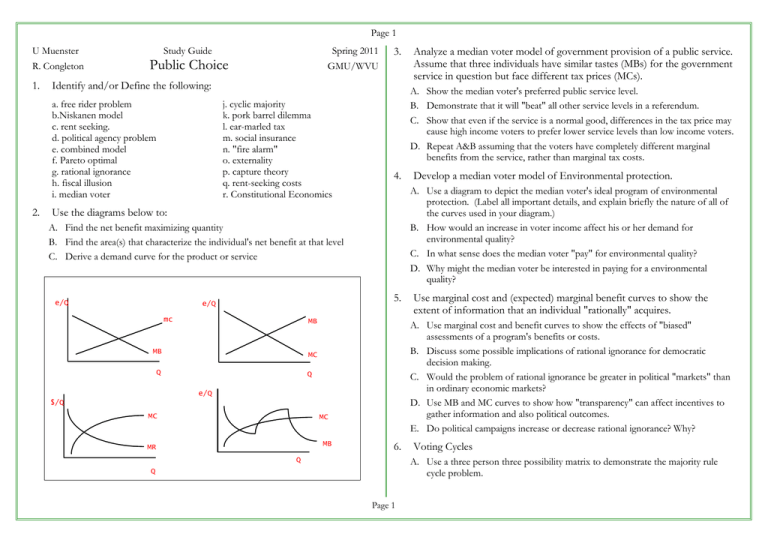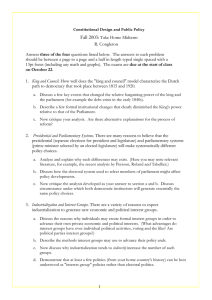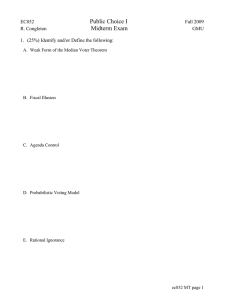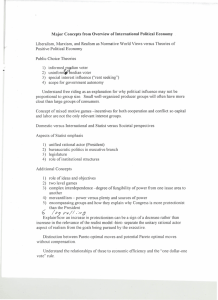Public Choice
advertisement

Page 1 U Muenster R. Congleton 1. Study Guide Public Choice 3. GMU/WVU Identify and/or Define the following: a. free rider problem b.Niskanen model c. rent seeking. d. political agency problem e. combined model f. Pareto optimal g. rational ignorance h. fiscal illusion i. median voter 2. Spring 2011 j. cyclic majority k. pork barrel dilemma l. ear-marled tax m. social insurance n. "fire alarm" o. externality p. capture theory q. rent-seeking costs r. Constitutional Economics A. Show the median voter's preferred public service level. B. Demonstrate that it will "beat" all other service levels in a referendum. C. Show that even if the service is a normal good, differences in the tax price may cause high income voters to prefer lower service levels than low income voters. D. Repeat A&B assuming that the voters have completely different marginal benefits from the service, rather than marginal tax costs. 4. A. Find the net benefit maximizing quantity B. Find the area(s) that characterize the individual's net benefit at that level C. Derive a demand curve for the product or service 5. e/Q mc MB MB Q e/Q $/Q MC MC MB MR Use marginal cost and (expected) marginal benefit curves to show the extent of information that an individual "rationally" acquires. A. Use marginal cost and benefit curves to show the effects of "biased" assessments of a program's benefits or costs. B. Discuss some possible implications of rational ignorance for democratic decision making. C. Would the problem of rational ignorance be greater in political "markets" than in ordinary economic markets? D. Use MB and MC curves to show how "transparency" can affect incentives to gather information and also political outcomes. E. Do political campaigns increase or decrease rational ignorance? Why? MC Q Develop a median voter model of Environmental protection. A. Use a diagram to depict the median voter's ideal program of environmental protection. (Label all important details, and explain briefly the nature of all of the curves used in your diagram.) B. How would an increase in voter income affect his or her demand for environmental quality? C. In what sense does the median voter "pay" for environmental quality? D. Why might the median voter be interested in paying for a environmental quality? Use the diagrams below to: e/Q Analyze a median voter model of government provision of a public service. Assume that three individuals have similar tastes (MBs) for the government service in question but face different tax prices (MCs). 6. Voting Cycles A. Use a three person three possibility matrix to demonstrate the majority rule cycle problem. Q Q Page 1 Page 2 B. Use a three person 2-dimensional issue space to demonstrate that voting cycles are very likely as soon as a second issue dimension is added. C. Identify all the Pareto optimal outcomes in "B", and demonstrate that it is possible to get majority approval for moves out of the Pareto set. D. Discuss how institutional arrangements can reduce the likelihood of such majority cycles. E. Show a three person configuration of ideal points that is cycle free in a 2-dimensional issue space. 7. C. Discuss how all of these models, in effect, "bound" the extent to which inefficient outcomes are generated by non-democratic policy making. 10. Under there any circumstances in which special interest groups (or models of their behavior) generate Pareto optimal policy outcomes? 11. Suppose that there are two risk neutral rent seekers, A and B, pursuing rents that will be granted by the following sort of mechanism: Ra = A/(A + B) - A Agency problems exist whenever an "agent" has interests that differ systematically from those of its "principal." 12. Describe how rent-seeking losses differ from the standard dead-weight losses of a Harberger (DWL) analysis of monopoly or tariffs. Depict the largest budget that a budget maximizing bureaucrat could ever obtain using "all or nothing" offers: A. Initially assume that Niskanen's view of bureaucratic behavior is correct. B. Prove that if you assume linear MB and MC curves, Niskanen's analysis implies that government is twice as large as it "should be." C. Show that with nonlinear MB and MC curves, government could be larger or smaller than twice the median voter's ideal service level. D. If Niskanen's model is correct , would voters still want to use bureaucracies to provide government services? Why or why not.. E. Suppose that bureaucrats do try to maximize their budgets but are unable to obtain Niskanen's extreme budget, how would this change your answer to B and D? 9. -B A. Find the Nash equilibrium of this game if A invests A dollars of effort and B invests B dollars of effort in the rent seeking contest.. B. Draw a diagram of your result for "a". C. How much of the prize (1 dollar) is dissipated at the Nash equilibrium. D. In what sense are rent-seeking activities wasteful? A. Under what circumstances might an elected representative have interests that differ from those of the median voter? B. How does electoral competition reduce agency problems? C. How does rational ignorance increase agency problems? D. Are their also agency problems within government? Illustrate and explain. 8. and Rb = B/(A + B) A. Are rent-seeking losses the result of miscounting the benefits of those doing the seeking? B. Why or why not? C. Gordon Tullock has argued that the rent-seeking "industry" is smaller than you would expect based upon the rents won by industries with effective lobbiests. Are there any reasons rent-seeking have higher rates of return than other types of business investments? 13. Suppose that interest groups provide external benefits and costs for individual's outside the group. For example, politically active farmers generate benefits for all farmers not just politically active farmers. What do externalities imply, if anything, about: Compare and contrast the external interest group models of Becker, Tullock, and Olson with the "internal" interest group models of Niskanen. A. Use a game matrix to analyze incentives for individuals to contribute to these four kinds of interest groups. B. What makes them different? Page 2 A. the scale of special interest group lobbying relative to that which maximizes net benefits for the group B. the extent of rent-seeking losses, C. the kinds of groups that are likely to be organize and be most effective D. Use MB and MC cost curves to illustrate your analysis, and explain the logic of your diagram. Page 3 14. Construct a diagram to represent a one public good median voter model of government finance. Assume that the government will divide up the cost of the public service equally among three voters who disagree about the optimal level of the public service. A. Characterize the median voter's preferred public service level. B. Does an increase in the median voter's wealth causes an increase in his preferred public service level? Explain. C. Use your diagram(s) to demonstrate that no one other than the median voter is satisfied with this level of public service. Is this evidence of political failure? D. Is there a series of different "tax prices" that could make them all agree to a single Pareto Efficient service level? 15. Use a "combined model" diagram to illustrate the tradeoffs that a candidate may make to obtain campaign resources (money and volunteers) from an interest group. (Assume that the other candidate has adopted the median voter's ideal point as his or her proposed platform.) A. Illustrate the case in which the candidate with the most money wins the election. B. Illustrate the case in which campaign resources are irrelevant. C. Illustrate the case in which both campaign resources and candidate position matter. D. Explain how rational ignorance affects the ability of candidates to pursue policies favored by interest groups rather than that favored by the median voter. F. How might interest groups affect the size and type of pension program that would be adopted? Is their influence likely to be larger or smaller than that associated with other government programs? Explain your reasoning. 17. Institutional reforms can theoretically reduce the problems of rent-seeking, voter cycles and voter ignorance. A. Suggest several institutional arrangements which affect either (or both) rent-seeking losses or improve voting outcomes. B. Construct fairly simple geometric representations of how the institutions in "a" affect voter, representative, or bureaucratic incentives and thereby political outcomes. C. Discuss alternative methods by which such institutional alternatives might be appraised. (Majoritarian, social net benefit maximizing, Paretian, Contractarian.) D. In what ways, if any, are the politics of institutional reform different from that of ordinary legislation? 18. To the extent that policy outcomes reflect an institutionally induced equilibrium of self-interested politically active individuals, policy reform will require institutional reform. 16. Analyze a typical voter's financial interest in the social security program. A. In what case would a voter prefer a modest government sponsored pension program. B. Are there cases in which a rational voter would prefer to have all of GNP devoted to social security programs? Explain why or why not? C. Use an age based median voter model to represent the size of a public pension program. D. Under what circumstances will the program be expanded (increase public pension levels)? E. Under what circumstances will the program be curtailed (reduce public pension levels). Page 3 A. Analyze geometrically the stabilizing effect of voting on issues one at a time in a two issue space voting model with three. Show that a spatial voting model implies an equilibrium in this case even in two-dimensional policy spaces. Does the order in which issues are voted on matter affect the policy decision? B. Now assume that one of the voters (perhaps the leader of the House) can control the order in which policies are voted on. Show the best outcome that he can achieve for him or herself after a series of 3 votes, beginning with a status quo in the Pareto set. Does the distribution of voter preference matter for this result? Can an agenda setter avoid the median voter outcome in a two dimensional issue space? (Assume that voter preferences lie along a straight line.) C. Are there any reasons to believe that current policies are not the results of ordinary spatial political equilibria? Why or why not? Page 4 19. Under proportional representation (PR), the legislature is composed of candidates selected from party lists in proportion to the number of votes received by the political parties. A. How does the median PR legislator's preference differ (if it does) from that of the median voter? B. How does the number of political parties represented in parliament differ from that of a plurality (first past the post) system like that of the United States? C. How does the effect of party discipline differ in plurality and PR systems? (Illustrate these differences with a diagram.) 20. Suppose that instead of an elected median voter government, an individual is randomly picked from the population as a whole and appointed dictator for life. A. Discuss reasons why a revenue maximizing dictator might provide public services. B. How would the policies of a randomly chosen dictator with one year terms differ from a dictator appointed for life? Explain your reasoning. Page 4



